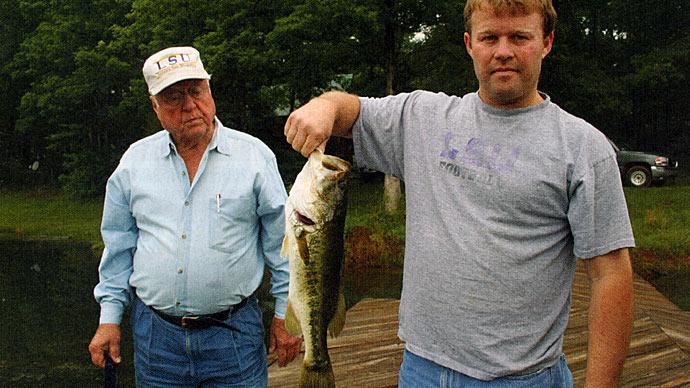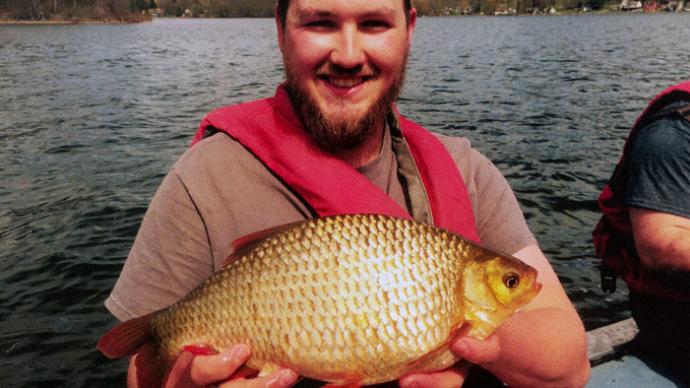Northern pike have NO place in ponds! Well, naturally, that's not completely true. It's almost true.
Let me explain.
There are sound reasons to avoid northern pike in ponds. But, there's one utility which might raise the opportunity in unique circumstances.
My phone rang one day, about ten years ago. On the other end of the line was an unhappy pond owner. It seems his three acre South Dakota pond yielded only small green sun-fish. He fished with live bait, artificial stuff...nothing but small green sunfish were caught.
He assumed his pond was loaded with stunted green sunfish, hardly the game fish of choice of discerning South Dakota pondmeisters.
Based on his woeful tale, I made an initial assumption his pond contained only sunfish. As often is the case with initial assumptions, we were wrong, both of us. The pond did contain green sunfish, but it also had northern pike.
The owner didn't even know pike were present. How in the world could the pond contain an aggressive predator such as northern pike, and the owner not even know it? You'll see in a moment.
From that initial consultation, we decided to apply rotenone (a fish toxicant) and renovate the entire fishery. Then, we could restock the pond and jumpstart his management program.
Good decision.
The rotenone told the tale. Boy, were we surprised? First thing we noticed, of course, was the lack of stunted sun-fish. They actually were NOT stunted. When we first applied rotenone, very few fish came to the surface. Those which rose were small, but they were plump little guys, not skinny as would be in a stunted population. That 3-acre pond should have supported hundreds of pounds of green sunfish, but only 10 pounds surfaced. That was the first sign something was wrong with our preliminary diagnosis.
As I scratched my head, wondering what the explanation for this situation was, the answer floated to the top. The first big northern pike appeared. Then, another. All told, his pond contained four northern pike. That's why the pond owner never saw, or caught one. Too few were present for him to know it.
BUT-those four pike averaged 7 pounds each. That's 28 pounds of northern pike in a 3-acre pond, or nearly 10 pounds/acre of water. Compared to waters across North America, that is a high biomass (poundage) of northern pike. But, think about that. Four fish lived in an area bigger than three football fields. What are the odds you might catch one?
Northern pike are toothy eating machines, seeking targets like a wet Patriot missile. Four pike suppressed abundant green sunfish in that pond. Just four fish! When anglers offered bobber and worm, they could catch sunfish, small ones. He assumed the typical situation of stunted (overpopu-lated) sunfish.
Being the superior pond management biologist I am, I assumed the same thing.
Northern pike are predators which truly select big prey, when such prey items are both available and vulnerable. Some studies indicate preferred prey items typically are 33-40% of the pike's body length. A 7-pound pike typically is 30 inches, or a bit longer. A 30 inch pike could consume 10-12 inch prey, if present and vulnerable to capture. Those of you who live in the North Country, think of yellow perch. Anglers love 10-12 inch perch. However, we fishermen compete directly with 7-pound northern pike for the same perch.
Northern pike crop panfish populations from the top! They inhale the big ones, and those fish are no longer available for anglers. That is not a top goal in pond management in the north.
Using largemouth bass as primary predator, small panfish numbers are thinned, and surviving panfish have less competition. Surviving panfish have more food per individual, grow faster, and reach larger sizes desired by anglers.
Our friend with the 3-acre pond had a high biomass of northern pike, but with only four fish, he had no sport value in angling for them. Low numbers of small sunfish weren't appealing either. Ever fillet a three inch green sunfish? Neither has he.
Don't use northern pike in pond management.
To better understand northern pike, take a look at normal feeding habits. Pike do have food preferences. They will bite into soft-rayed fishes such as white suckers or rainbow trout, before tackling spiny-rayed fishes such as yellow perch or bluegill. When taking spiny-rayed fishes, they will eat the fusiform (torpedo-shaped) yellow perch before they consume the compressiform (saucer-shaped) bluegill.
We completed an interesting study in a 60-acre lake in north-central Nebraska after northern pike gained access to what had been a fish community of largemouth bass, bluegill, and yellow perch. In four years of sampling, we went from finding the first two small northern pike in the lake, to a biomass of 20 pounds of pike/acre. Before pike entered the picture, the pond had high quality bluegill and yellow perch populations. Bluegills longer than 8 inches were common, and a 10-incher was occasionally caught. Perch over 10 inches were common, and 12-inchers were occasionally caught. After four years, northern pike cropped the fusiform yellow perch in the lake. Perch abundance declined 75%, and most remaining perch were less than 8 inches long. They weren't stunted. Perch were plump, and growing faster than our pre-pike sample sets. Pike were snuffing out the larger ones, reducing both density of perch and sizes available to anglers. Anglers lost interest in this lake, since most perch were 8 inches long.
One big surprise was pike hurt quality of compressiform bluegills in this lake. After four years, bluegill abundance was reduced by about 90%. Most bluegills were less than 6 inches long, even though they were growing faster than before pike got into the lake. Obviously 20 pounds/acre of northern pike is too much, and they were eating their way through panfish in the lake. This is not a desirable situation if pan-fish fillets are a management objective for a small lake or pond.
OK, so what about one potential constructive use of northern pike? In a nutshell, I will say that largemouth bass will average larger sizes where northern pike are present. Let's go back to our 60-acre Nebraska lake as an example. Before pike got into that lake, largemouth bass were abundant, and most were shorter than 12 inches. That's what created high quality perch and bluegills. Small bass thinned small panfish, and survivors grew fast and reached large sizes. After pike were present for four years, we saw a 70% decline in largemouth bass abundance. Pike not only ate perch and larger blue-gill, they preyed on small to intermediate size bass, perhaps those up to 12 inches long. As a result, bass growth rates increased, and more big bass were present. Before pike, only 29% of bass were longer than 12 inches, and only 9% were longer than 15 inches. Four years later, 91% of bass were over 12 inches long, and 21% were more than 15 inches long.
We saw a similar occurrence in a study on three ponds in central South Dakota. After northern pike introduction, increased sizes of largemouth were present in the ponds. At the same time, quality of bluegill populations remained high, while yellow perch abundance and quality declined. Pike were not as abundant as the 20 pounds/ acre that developed in the Nebraska lake.
So, a truly interested pond owner MIGHT be able to use northern pike to maintain or improve quality (sizes) of largemouth bass in a pond. I would only undertake such a management strategy with someone who understood the risks involved. The primary problem could be controlling the number of northern pike that are present. If reproduction is too successful and too many northern pike inhabit a pond, problems undoubtedly will occur when pike eat themselves out of house and home, at the expense of other fish species in the pond.
Here's the meat. If you choose to use pike, understand their feeding habits, and be prepared to take corrective action. It won't be easy. If you choose to use pike to correct a stunted bass situation in northern ponds, be aware the toothy predator can reproduce, and while solving one problem, can become another one.
Dr. David W. Willis is a professor in the Department of Wildlife and Fisheries Sciences, South Dakota State University in Brookings. He frequents the Pond Boss forum at www.pondboss.com and can be reached there.
Reprinted with permission from Pond Boss Magazine



